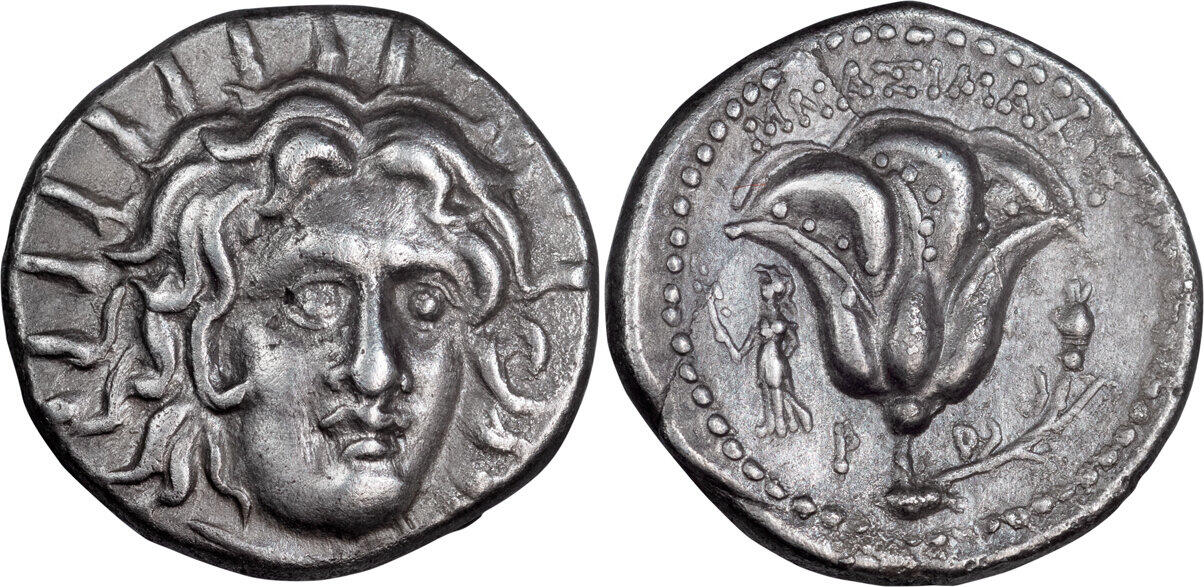Rhodes, silver, didrachms (250-230 BCE)
From SILVER
250 BCE - 230 BCE Silver 22,636 kg
Description
| ObverseInscription or printing placed on the obverse.: | Radiate head of Helios facing, slightly r. |
| ReverseInscription or printing placed on the reverse.: | ΜΝΑΣΙΜΑΧΟΣ above (Greek).Rose with bud on r., P - O to either side of stem, in field l. Athena standing |
Mint and issuing power
| MintIdentifies the place of manufacture or issue of a numismatic object.: | Rhodes | Ancient regionAncient region.: | Caria (islands) | Modern countryModern country: Greece | AuthorityIdentifies the issuing power. The authority can be "pretended" when the name or the portrait of X is on the coin but he/she was not the issuing power. It can also be "uncertain" when there is no mention of X on the coin but he/she was the issuing power according to the historical sources: | Rhodian power |
Chronology
| FromIdentifies the initial date in a range assigned in a numismatic context. | 250 BCE | toIdentifies the final date in a range assigned in a numismatic context.. | 230 BCE | PeriodTime period of the numismatic object.: Hellenistic 323-30 BC |
Physical description
| MetalThe physical material (usually metal) from which an object is made.: | Silver |
Median weightMedian of the weights of numismatic objects (in grams). in grams | 6.50 | DenominationTerm indicating the value of a numismatic object. Examples: tetradrachm, chalkous, denarius.: | didrachm |
StandardStandard.: | Rhodian |
Image

S2094 Rhodes didrachms Ashton 206-209.jpg [1]
References
| Die study referencePublication of the study: | Ashton 20011Ashton 2001, p. 106, n° 206-209 | ||
| Coin series referenceReference to coin series study: | Sear II2Sear II, n° 5048-5049, HGC 63HGC 6, n° 1439 | ||
| Coin series web referenceCoin series web references: | |||
Obverse dies distribution
no distribution is available
Reverse dies distribution
no distribution is available
Quantification
| Number of obversesNumber of obverse dies. ᵖ (o) | 159 | Number of singletons (o1)The number of singleton coins. ᵖ | |
| Number of reverse diesNumber of reverse dies. (r) | Number of coinsNumber of coins. (n) | 860 | |
| Coins per obverse dieNumber of coins per obverse die. (n/o) | 5.41 | Coins per reverse dieNumber of coins per reverse die. (n/r) | |
| Reverse per obverse ratioRatio of obverse dies divided by reverse dies. (r/o) | Percentage of singletons (o1)number of coins (n) divided by the number of singletons (o1) ᵖ | % | |
| Original number of dies (O) (Carter 1983 formula)The estimation of the number of coins according to Carter 1983 ᵖ | 174.12 | Coins struck if 20,000 as average productivity per dieCoins made if the average productivity for obverses (according to Carter) is 20,000. ᵖ | 3,482,400 |
| Original number of dies (O) (Esty 2011 formula)The estimation of the number of coins according to the singleton formula in Esty 2011 ᵖ (O) | 195.06 | Survival rate if 20,000 as average productivity per dieSurvival rate if average productivity is 20,000. ᵖ | 0.00025 |
| Coverage (o = % of O) (Esty 1984 formula)Esty 1984 - coverage (% of O) ᵖ (o = % of O) | % | Die productivity if survival rate 1/2,000Average productivity if survival rate is 1/2,000. ᵖ | 9,878.24 |
| Weight of silver (in kg) if 20,000 coins per die (O = Carter formula)Carter 1983 * Median weight * 20000 (*10 if gold or electrum) ᵖ | 22,636 kg <br /> 22,636 kg | Die productivity if survival rate 1/5,000Average productivity if survival rate is 1/5,000. ᵖ | 24,695.61 |
Remarks